University Finance Assignment: Questions and Answers Solution
VerifiedAdded on 2022/08/13
|18
|3599
|7
Homework Assignment
AI Summary
This document presents a comprehensive solution to a financial management assignment. The solution addresses three key questions, including capital budgeting, WACC, and retirement planning. The first question involves the analysis of a replacement project, calculating initial outlay, after-tax cash flows, NPV, IRR, and profitability index. The second question delves into the calculation of the weighted average cost of capital (WACC) under both market and book value weights, along with the discussion of its implications. The third question focuses on retirement planning, including the calculation of future values of investments, monthly withdrawals, and bond investments. The assignment also includes detailed calculations, formulas, and explanations to support the answers. The assignment covers topics like the impact of depreciation on cash flows, payback period analysis, and the relationship between discount rates and NPV.
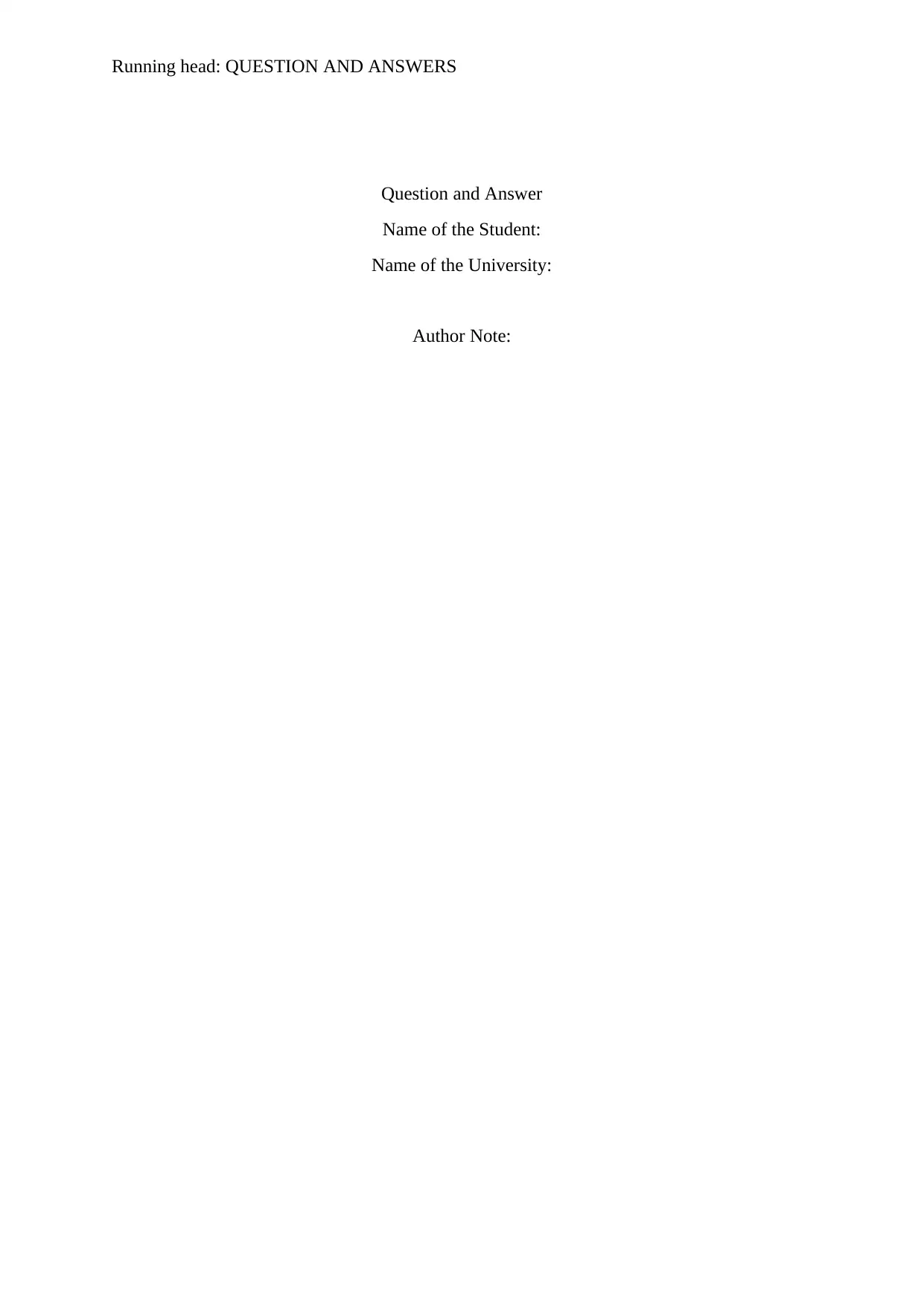
Running head: QUESTION AND ANSWERS
Question and Answer
Name of the Student:
Name of the University:
Author Note:
Question and Answer
Name of the Student:
Name of the University:
Author Note:
Paraphrase This Document
Need a fresh take? Get an instant paraphrase of this document with our AI Paraphraser
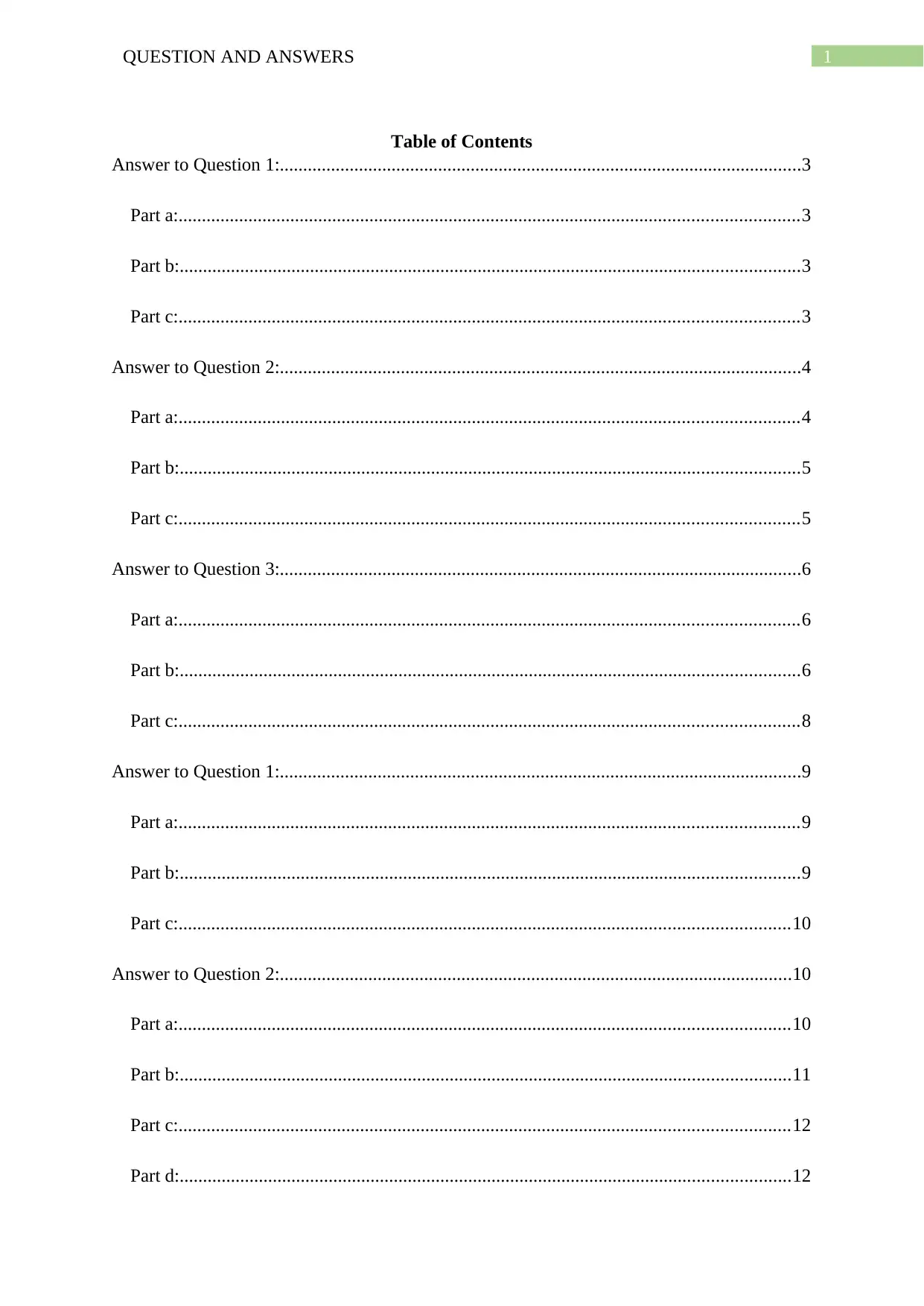
1QUESTION AND ANSWERS
Table of Contents
Answer to Question 1:................................................................................................................3
Part a:.....................................................................................................................................3
Part b:.....................................................................................................................................3
Part c:.....................................................................................................................................3
Answer to Question 2:................................................................................................................4
Part a:.....................................................................................................................................4
Part b:.....................................................................................................................................5
Part c:.....................................................................................................................................5
Answer to Question 3:................................................................................................................6
Part a:.....................................................................................................................................6
Part b:.....................................................................................................................................6
Part c:.....................................................................................................................................8
Answer to Question 1:................................................................................................................9
Part a:.....................................................................................................................................9
Part b:.....................................................................................................................................9
Part c:...................................................................................................................................10
Answer to Question 2:..............................................................................................................10
Part a:...................................................................................................................................10
Part b:...................................................................................................................................11
Part c:...................................................................................................................................12
Part d:...................................................................................................................................12
Table of Contents
Answer to Question 1:................................................................................................................3
Part a:.....................................................................................................................................3
Part b:.....................................................................................................................................3
Part c:.....................................................................................................................................3
Answer to Question 2:................................................................................................................4
Part a:.....................................................................................................................................4
Part b:.....................................................................................................................................5
Part c:.....................................................................................................................................5
Answer to Question 3:................................................................................................................6
Part a:.....................................................................................................................................6
Part b:.....................................................................................................................................6
Part c:.....................................................................................................................................8
Answer to Question 1:................................................................................................................9
Part a:.....................................................................................................................................9
Part b:.....................................................................................................................................9
Part c:...................................................................................................................................10
Answer to Question 2:..............................................................................................................10
Part a:...................................................................................................................................10
Part b:...................................................................................................................................11
Part c:...................................................................................................................................12
Part d:...................................................................................................................................12
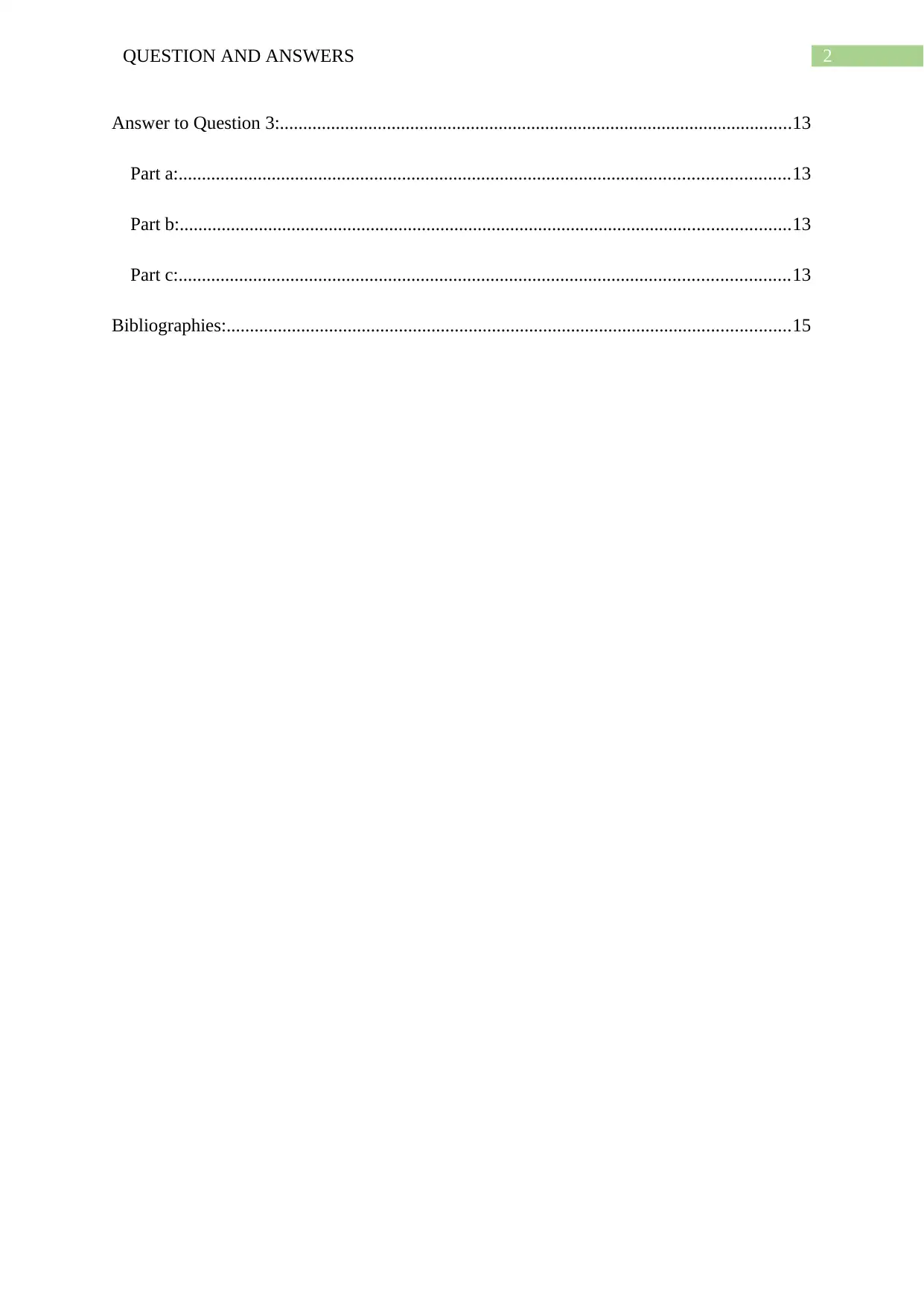
2QUESTION AND ANSWERS
Answer to Question 3:..............................................................................................................13
Part a:...................................................................................................................................13
Part b:...................................................................................................................................13
Part c:...................................................................................................................................13
Bibliographies:.........................................................................................................................15
Answer to Question 3:..............................................................................................................13
Part a:...................................................................................................................................13
Part b:...................................................................................................................................13
Part c:...................................................................................................................................13
Bibliographies:.........................................................................................................................15
⊘ This is a preview!⊘
Do you want full access?
Subscribe today to unlock all pages.

Trusted by 1+ million students worldwide
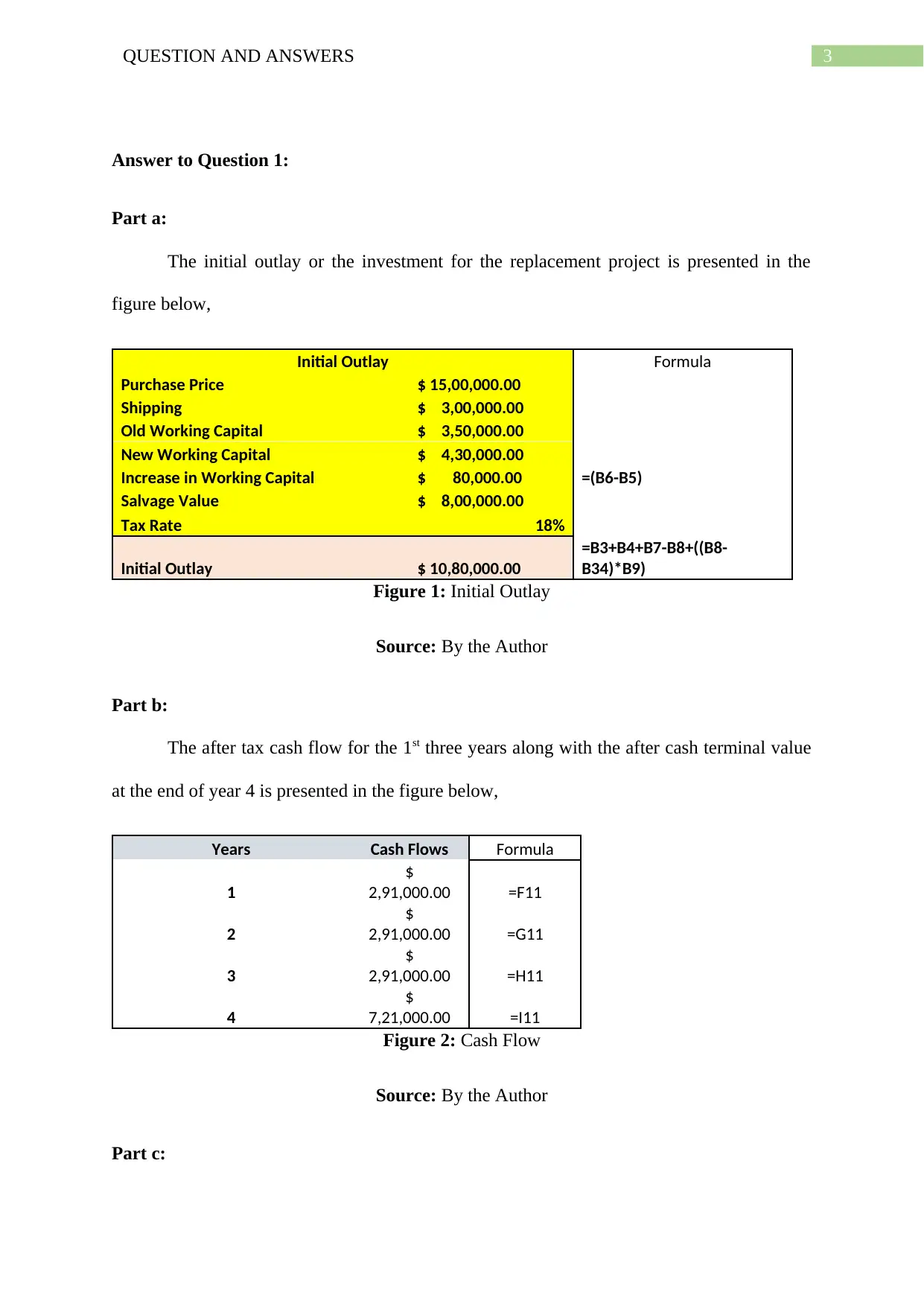
3QUESTION AND ANSWERS
Answer to Question 1:
Part a:
The initial outlay or the investment for the replacement project is presented in the
figure below,
Initial Outlay Formula
Purchase Price $ 15,00,000.00
Shipping $ 3,00,000.00
Old Working Capital $ 3,50,000.00
New Working Capital $ 4,30,000.00
Increase in Working Capital $ 80,000.00 =(B6-B5)
Salvage Value $ 8,00,000.00
Tax Rate 18%
Initial Outlay $ 10,80,000.00
=B3+B4+B7-B8+((B8-
B34)*B9)
Figure 1: Initial Outlay
Source: By the Author
Part b:
The after tax cash flow for the 1st three years along with the after cash terminal value
at the end of year 4 is presented in the figure below,
Years Cash Flows Formula
1
$
2,91,000.00 =F11
2
$
2,91,000.00 =G11
3
$
2,91,000.00 =H11
4
$
7,21,000.00 =I11
Figure 2: Cash Flow
Source: By the Author
Part c:
Answer to Question 1:
Part a:
The initial outlay or the investment for the replacement project is presented in the
figure below,
Initial Outlay Formula
Purchase Price $ 15,00,000.00
Shipping $ 3,00,000.00
Old Working Capital $ 3,50,000.00
New Working Capital $ 4,30,000.00
Increase in Working Capital $ 80,000.00 =(B6-B5)
Salvage Value $ 8,00,000.00
Tax Rate 18%
Initial Outlay $ 10,80,000.00
=B3+B4+B7-B8+((B8-
B34)*B9)
Figure 1: Initial Outlay
Source: By the Author
Part b:
The after tax cash flow for the 1st three years along with the after cash terminal value
at the end of year 4 is presented in the figure below,
Years Cash Flows Formula
1
$
2,91,000.00 =F11
2
$
2,91,000.00 =G11
3
$
2,91,000.00 =H11
4
$
7,21,000.00 =I11
Figure 2: Cash Flow
Source: By the Author
Part c:
Paraphrase This Document
Need a fresh take? Get an instant paraphrase of this document with our AI Paraphraser
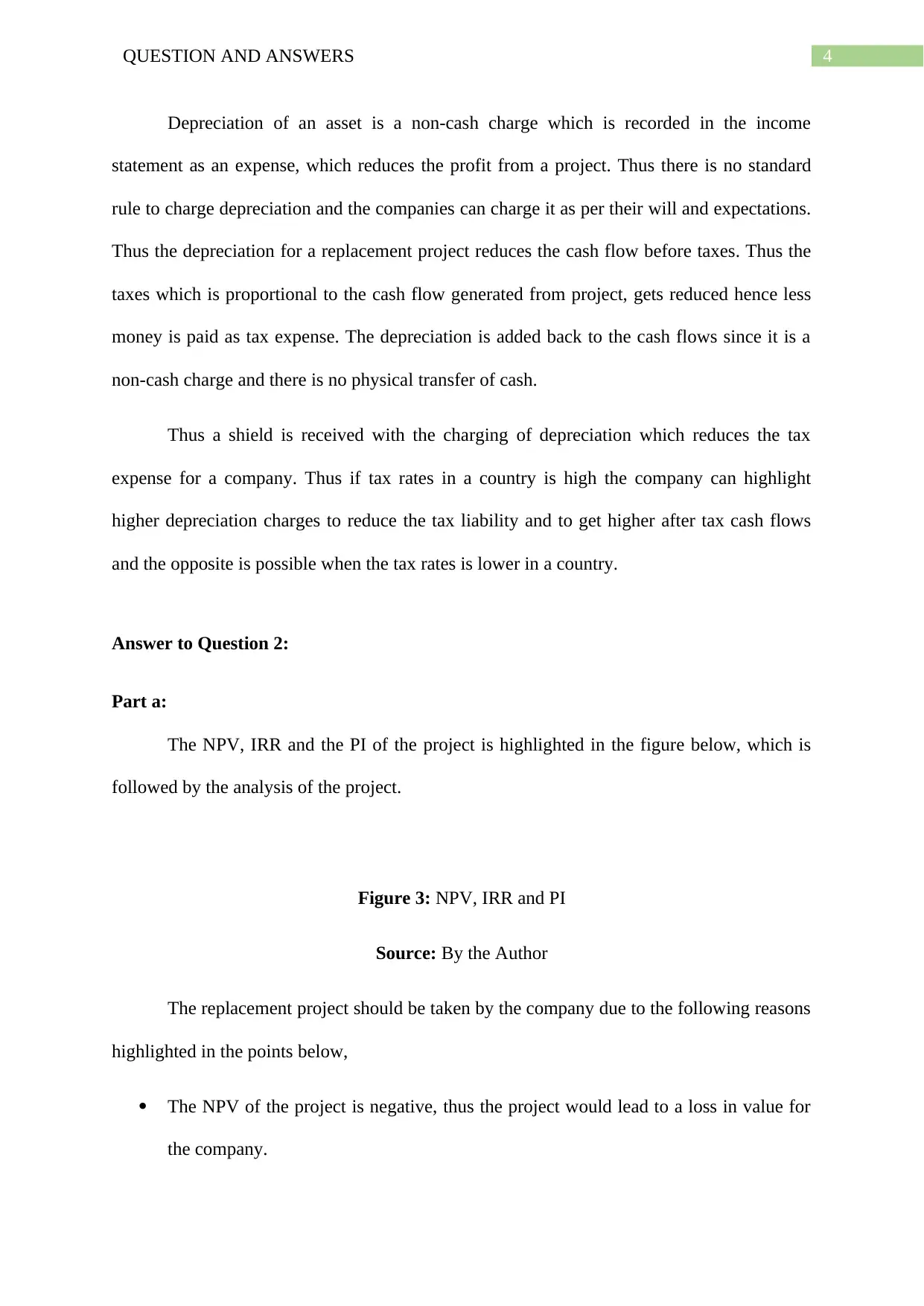
4QUESTION AND ANSWERS
Depreciation of an asset is a non-cash charge which is recorded in the income
statement as an expense, which reduces the profit from a project. Thus there is no standard
rule to charge depreciation and the companies can charge it as per their will and expectations.
Thus the depreciation for a replacement project reduces the cash flow before taxes. Thus the
taxes which is proportional to the cash flow generated from project, gets reduced hence less
money is paid as tax expense. The depreciation is added back to the cash flows since it is a
non-cash charge and there is no physical transfer of cash.
Thus a shield is received with the charging of depreciation which reduces the tax
expense for a company. Thus if tax rates in a country is high the company can highlight
higher depreciation charges to reduce the tax liability and to get higher after tax cash flows
and the opposite is possible when the tax rates is lower in a country.
Answer to Question 2:
Part a:
The NPV, IRR and the PI of the project is highlighted in the figure below, which is
followed by the analysis of the project.
Figure 3: NPV, IRR and PI
Source: By the Author
The replacement project should be taken by the company due to the following reasons
highlighted in the points below,
The NPV of the project is negative, thus the project would lead to a loss in value for
the company.
Depreciation of an asset is a non-cash charge which is recorded in the income
statement as an expense, which reduces the profit from a project. Thus there is no standard
rule to charge depreciation and the companies can charge it as per their will and expectations.
Thus the depreciation for a replacement project reduces the cash flow before taxes. Thus the
taxes which is proportional to the cash flow generated from project, gets reduced hence less
money is paid as tax expense. The depreciation is added back to the cash flows since it is a
non-cash charge and there is no physical transfer of cash.
Thus a shield is received with the charging of depreciation which reduces the tax
expense for a company. Thus if tax rates in a country is high the company can highlight
higher depreciation charges to reduce the tax liability and to get higher after tax cash flows
and the opposite is possible when the tax rates is lower in a country.
Answer to Question 2:
Part a:
The NPV, IRR and the PI of the project is highlighted in the figure below, which is
followed by the analysis of the project.
Figure 3: NPV, IRR and PI
Source: By the Author
The replacement project should be taken by the company due to the following reasons
highlighted in the points below,
The NPV of the project is negative, thus the project would lead to a loss in value for
the company.
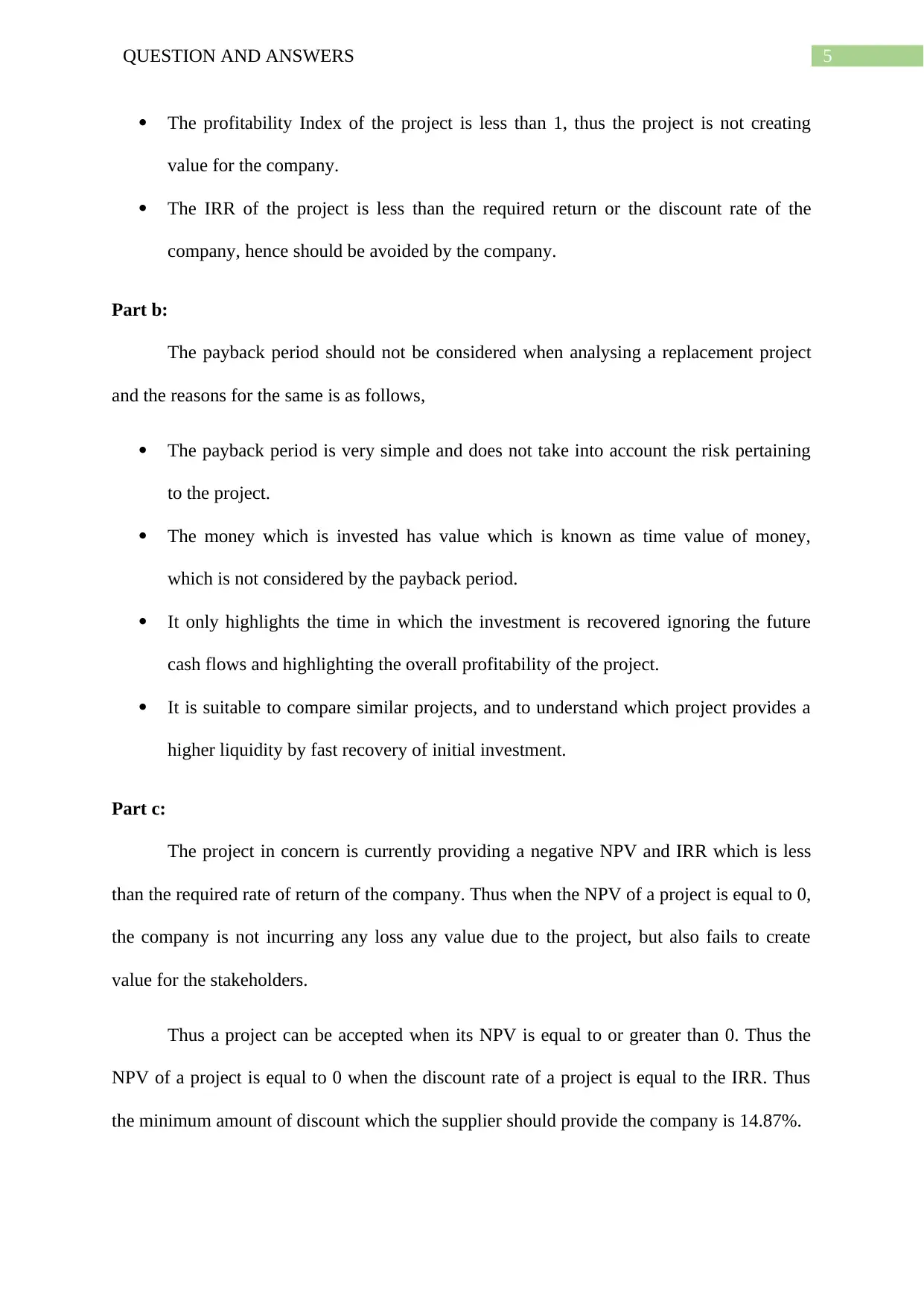
5QUESTION AND ANSWERS
The profitability Index of the project is less than 1, thus the project is not creating
value for the company.
The IRR of the project is less than the required return or the discount rate of the
company, hence should be avoided by the company.
Part b:
The payback period should not be considered when analysing a replacement project
and the reasons for the same is as follows,
The payback period is very simple and does not take into account the risk pertaining
to the project.
The money which is invested has value which is known as time value of money,
which is not considered by the payback period.
It only highlights the time in which the investment is recovered ignoring the future
cash flows and highlighting the overall profitability of the project.
It is suitable to compare similar projects, and to understand which project provides a
higher liquidity by fast recovery of initial investment.
Part c:
The project in concern is currently providing a negative NPV and IRR which is less
than the required rate of return of the company. Thus when the NPV of a project is equal to 0,
the company is not incurring any loss any value due to the project, but also fails to create
value for the stakeholders.
Thus a project can be accepted when its NPV is equal to or greater than 0. Thus the
NPV of a project is equal to 0 when the discount rate of a project is equal to the IRR. Thus
the minimum amount of discount which the supplier should provide the company is 14.87%.
The profitability Index of the project is less than 1, thus the project is not creating
value for the company.
The IRR of the project is less than the required return or the discount rate of the
company, hence should be avoided by the company.
Part b:
The payback period should not be considered when analysing a replacement project
and the reasons for the same is as follows,
The payback period is very simple and does not take into account the risk pertaining
to the project.
The money which is invested has value which is known as time value of money,
which is not considered by the payback period.
It only highlights the time in which the investment is recovered ignoring the future
cash flows and highlighting the overall profitability of the project.
It is suitable to compare similar projects, and to understand which project provides a
higher liquidity by fast recovery of initial investment.
Part c:
The project in concern is currently providing a negative NPV and IRR which is less
than the required rate of return of the company. Thus when the NPV of a project is equal to 0,
the company is not incurring any loss any value due to the project, but also fails to create
value for the stakeholders.
Thus a project can be accepted when its NPV is equal to or greater than 0. Thus the
NPV of a project is equal to 0 when the discount rate of a project is equal to the IRR. Thus
the minimum amount of discount which the supplier should provide the company is 14.87%.
⊘ This is a preview!⊘
Do you want full access?
Subscribe today to unlock all pages.

Trusted by 1+ million students worldwide
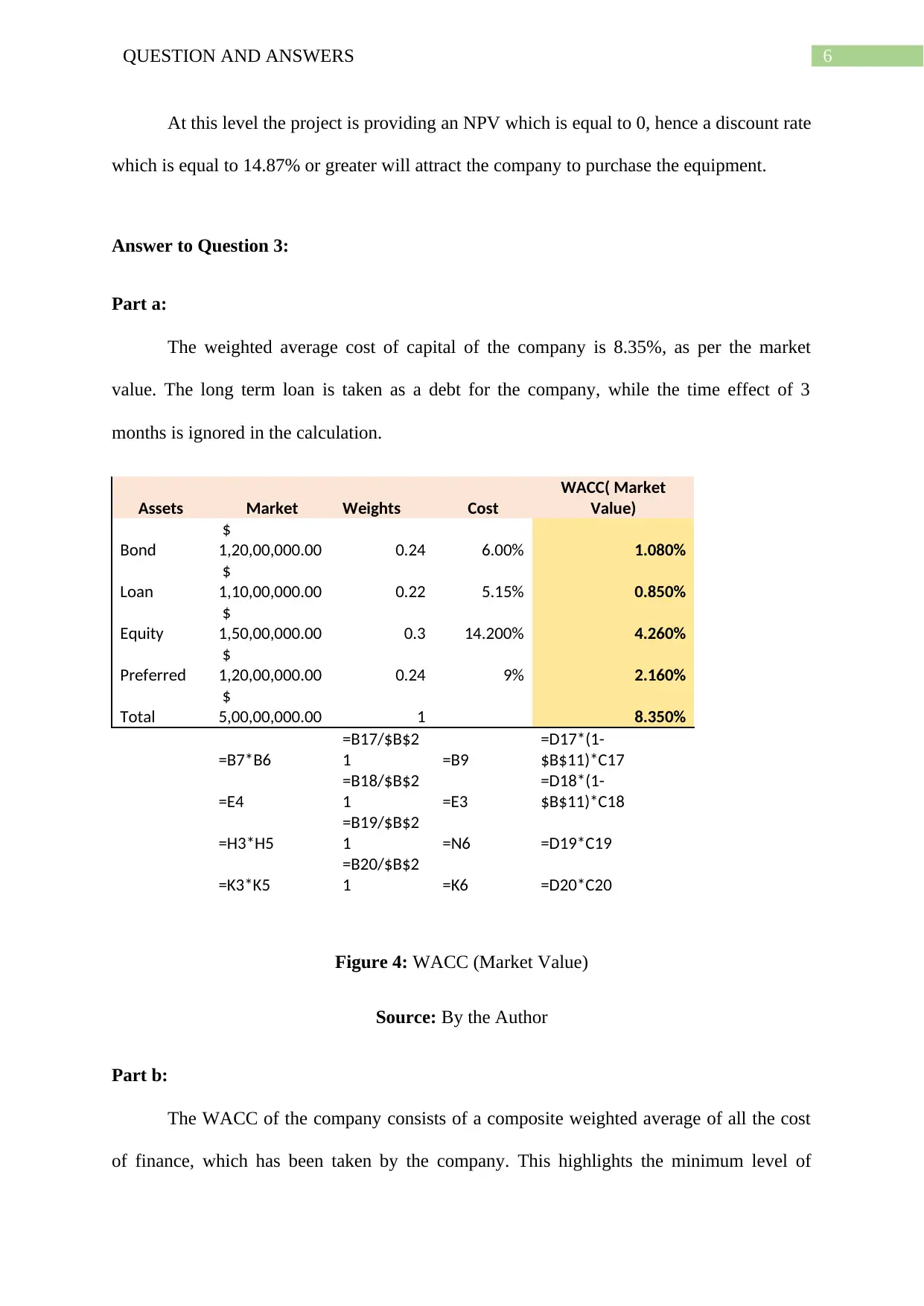
6QUESTION AND ANSWERS
At this level the project is providing an NPV which is equal to 0, hence a discount rate
which is equal to 14.87% or greater will attract the company to purchase the equipment.
Answer to Question 3:
Part a:
The weighted average cost of capital of the company is 8.35%, as per the market
value. The long term loan is taken as a debt for the company, while the time effect of 3
months is ignored in the calculation.
Assets Market Weights Cost
WACC( Market
Value)
Bond
$
1,20,00,000.00 0.24 6.00% 1.080%
Loan
$
1,10,00,000.00 0.22 5.15% 0.850%
Equity
$
1,50,00,000.00 0.3 14.200% 4.260%
Preferred
$
1,20,00,000.00 0.24 9% 2.160%
Total
$
5,00,00,000.00 1 8.350%
=B7*B6
=B17/$B$2
1 =B9
=D17*(1-
$B$11)*C17
=E4
=B18/$B$2
1 =E3
=D18*(1-
$B$11)*C18
=H3*H5
=B19/$B$2
1 =N6 =D19*C19
=K3*K5
=B20/$B$2
1 =K6 =D20*C20
Figure 4: WACC (Market Value)
Source: By the Author
Part b:
The WACC of the company consists of a composite weighted average of all the cost
of finance, which has been taken by the company. This highlights the minimum level of
At this level the project is providing an NPV which is equal to 0, hence a discount rate
which is equal to 14.87% or greater will attract the company to purchase the equipment.
Answer to Question 3:
Part a:
The weighted average cost of capital of the company is 8.35%, as per the market
value. The long term loan is taken as a debt for the company, while the time effect of 3
months is ignored in the calculation.
Assets Market Weights Cost
WACC( Market
Value)
Bond
$
1,20,00,000.00 0.24 6.00% 1.080%
Loan
$
1,10,00,000.00 0.22 5.15% 0.850%
Equity
$
1,50,00,000.00 0.3 14.200% 4.260%
Preferred
$
1,20,00,000.00 0.24 9% 2.160%
Total
$
5,00,00,000.00 1 8.350%
=B7*B6
=B17/$B$2
1 =B9
=D17*(1-
$B$11)*C17
=E4
=B18/$B$2
1 =E3
=D18*(1-
$B$11)*C18
=H3*H5
=B19/$B$2
1 =N6 =D19*C19
=K3*K5
=B20/$B$2
1 =K6 =D20*C20
Figure 4: WACC (Market Value)
Source: By the Author
Part b:
The WACC of the company consists of a composite weighted average of all the cost
of finance, which has been taken by the company. This highlights the minimum level of
Paraphrase This Document
Need a fresh take? Get an instant paraphrase of this document with our AI Paraphraser
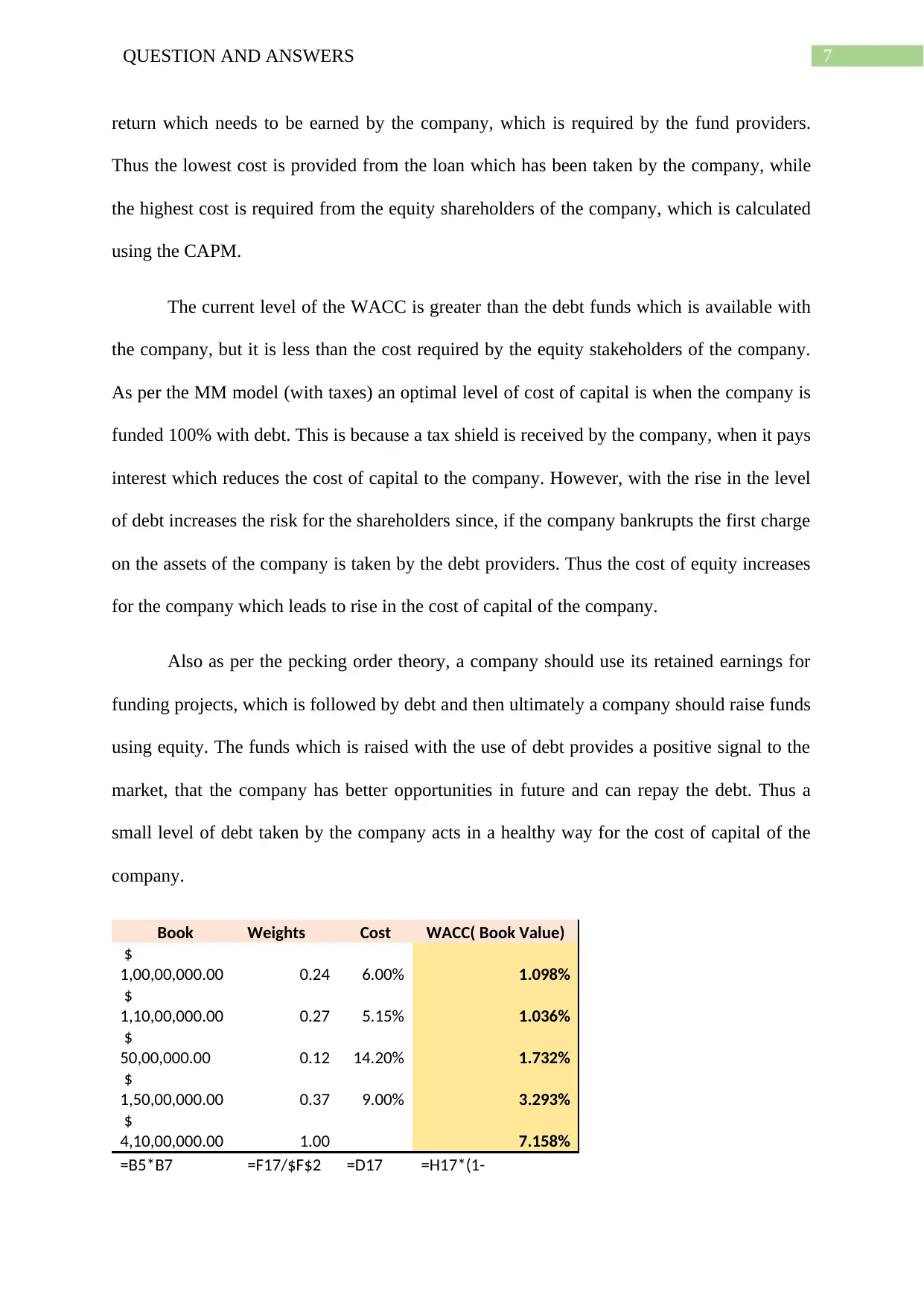
7QUESTION AND ANSWERS
return which needs to be earned by the company, which is required by the fund providers.
Thus the lowest cost is provided from the loan which has been taken by the company, while
the highest cost is required from the equity shareholders of the company, which is calculated
using the CAPM.
The current level of the WACC is greater than the debt funds which is available with
the company, but it is less than the cost required by the equity stakeholders of the company.
As per the MM model (with taxes) an optimal level of cost of capital is when the company is
funded 100% with debt. This is because a tax shield is received by the company, when it pays
interest which reduces the cost of capital to the company. However, with the rise in the level
of debt increases the risk for the shareholders since, if the company bankrupts the first charge
on the assets of the company is taken by the debt providers. Thus the cost of equity increases
for the company which leads to rise in the cost of capital of the company.
Also as per the pecking order theory, a company should use its retained earnings for
funding projects, which is followed by debt and then ultimately a company should raise funds
using equity. The funds which is raised with the use of debt provides a positive signal to the
market, that the company has better opportunities in future and can repay the debt. Thus a
small level of debt taken by the company acts in a healthy way for the cost of capital of the
company.
Book Weights Cost WACC( Book Value)
$
1,00,00,000.00 0.24 6.00% 1.098%
$
1,10,00,000.00 0.27 5.15% 1.036%
$
50,00,000.00 0.12 14.20% 1.732%
$
1,50,00,000.00 0.37 9.00% 3.293%
$
4,10,00,000.00 1.00 7.158%
=B5*B7 =F17/$F$2 =D17 =H17*(1-
return which needs to be earned by the company, which is required by the fund providers.
Thus the lowest cost is provided from the loan which has been taken by the company, while
the highest cost is required from the equity shareholders of the company, which is calculated
using the CAPM.
The current level of the WACC is greater than the debt funds which is available with
the company, but it is less than the cost required by the equity stakeholders of the company.
As per the MM model (with taxes) an optimal level of cost of capital is when the company is
funded 100% with debt. This is because a tax shield is received by the company, when it pays
interest which reduces the cost of capital to the company. However, with the rise in the level
of debt increases the risk for the shareholders since, if the company bankrupts the first charge
on the assets of the company is taken by the debt providers. Thus the cost of equity increases
for the company which leads to rise in the cost of capital of the company.
Also as per the pecking order theory, a company should use its retained earnings for
funding projects, which is followed by debt and then ultimately a company should raise funds
using equity. The funds which is raised with the use of debt provides a positive signal to the
market, that the company has better opportunities in future and can repay the debt. Thus a
small level of debt taken by the company acts in a healthy way for the cost of capital of the
company.
Book Weights Cost WACC( Book Value)
$
1,00,00,000.00 0.24 6.00% 1.098%
$
1,10,00,000.00 0.27 5.15% 1.036%
$
50,00,000.00 0.12 14.20% 1.732%
$
1,50,00,000.00 0.37 9.00% 3.293%
$
4,10,00,000.00 1.00 7.158%
=B5*B7 =F17/$F$2 =D17 =H17*(1-
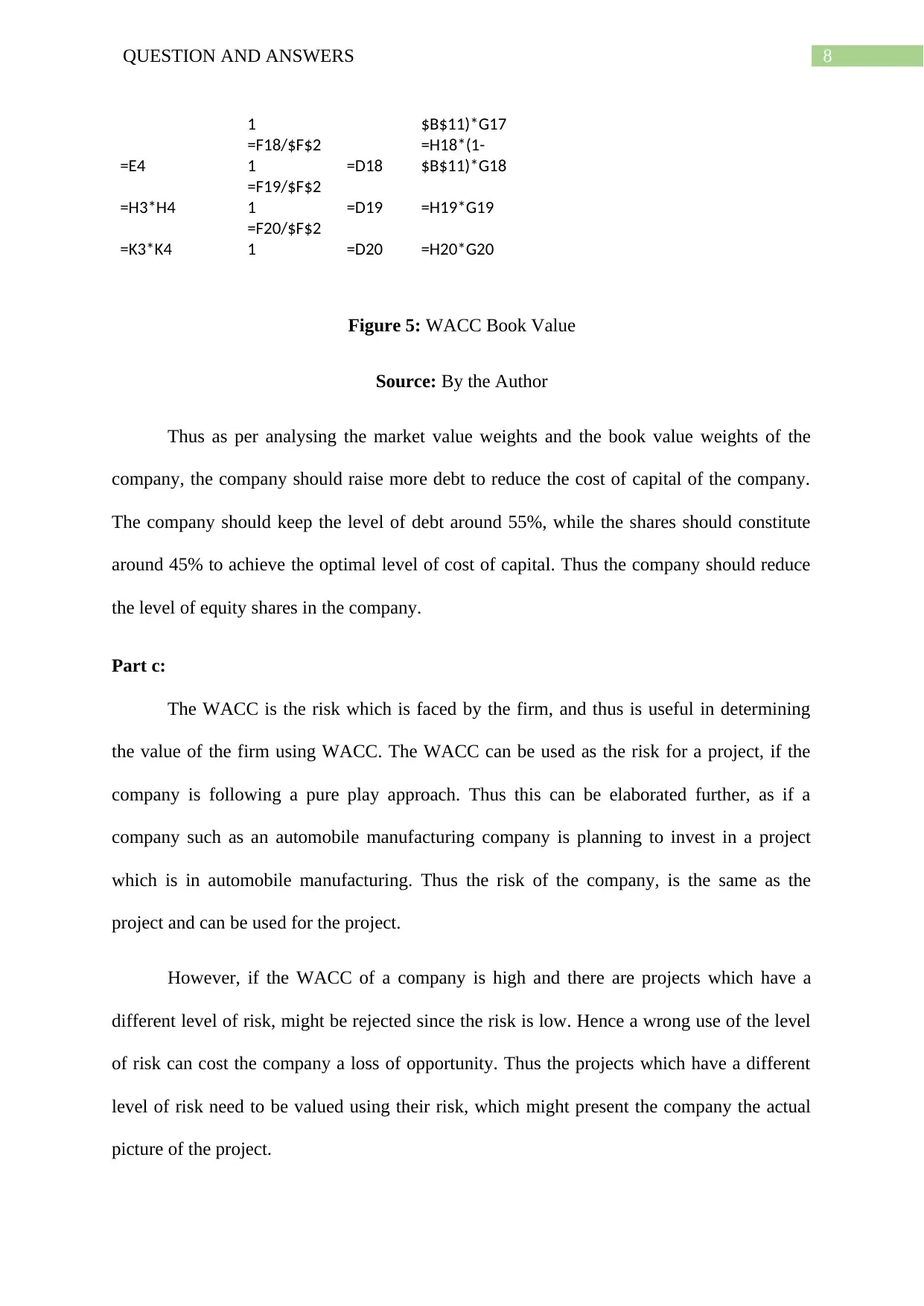
8QUESTION AND ANSWERS
1 $B$11)*G17
=E4
=F18/$F$2
1 =D18
=H18*(1-
$B$11)*G18
=H3*H4
=F19/$F$2
1 =D19 =H19*G19
=K3*K4
=F20/$F$2
1 =D20 =H20*G20
Figure 5: WACC Book Value
Source: By the Author
Thus as per analysing the market value weights and the book value weights of the
company, the company should raise more debt to reduce the cost of capital of the company.
The company should keep the level of debt around 55%, while the shares should constitute
around 45% to achieve the optimal level of cost of capital. Thus the company should reduce
the level of equity shares in the company.
Part c:
The WACC is the risk which is faced by the firm, and thus is useful in determining
the value of the firm using WACC. The WACC can be used as the risk for a project, if the
company is following a pure play approach. Thus this can be elaborated further, as if a
company such as an automobile manufacturing company is planning to invest in a project
which is in automobile manufacturing. Thus the risk of the company, is the same as the
project and can be used for the project.
However, if the WACC of a company is high and there are projects which have a
different level of risk, might be rejected since the risk is low. Hence a wrong use of the level
of risk can cost the company a loss of opportunity. Thus the projects which have a different
level of risk need to be valued using their risk, which might present the company the actual
picture of the project.
1 $B$11)*G17
=E4
=F18/$F$2
1 =D18
=H18*(1-
$B$11)*G18
=H3*H4
=F19/$F$2
1 =D19 =H19*G19
=K3*K4
=F20/$F$2
1 =D20 =H20*G20
Figure 5: WACC Book Value
Source: By the Author
Thus as per analysing the market value weights and the book value weights of the
company, the company should raise more debt to reduce the cost of capital of the company.
The company should keep the level of debt around 55%, while the shares should constitute
around 45% to achieve the optimal level of cost of capital. Thus the company should reduce
the level of equity shares in the company.
Part c:
The WACC is the risk which is faced by the firm, and thus is useful in determining
the value of the firm using WACC. The WACC can be used as the risk for a project, if the
company is following a pure play approach. Thus this can be elaborated further, as if a
company such as an automobile manufacturing company is planning to invest in a project
which is in automobile manufacturing. Thus the risk of the company, is the same as the
project and can be used for the project.
However, if the WACC of a company is high and there are projects which have a
different level of risk, might be rejected since the risk is low. Hence a wrong use of the level
of risk can cost the company a loss of opportunity. Thus the projects which have a different
level of risk need to be valued using their risk, which might present the company the actual
picture of the project.
⊘ This is a preview!⊘
Do you want full access?
Subscribe today to unlock all pages.

Trusted by 1+ million students worldwide
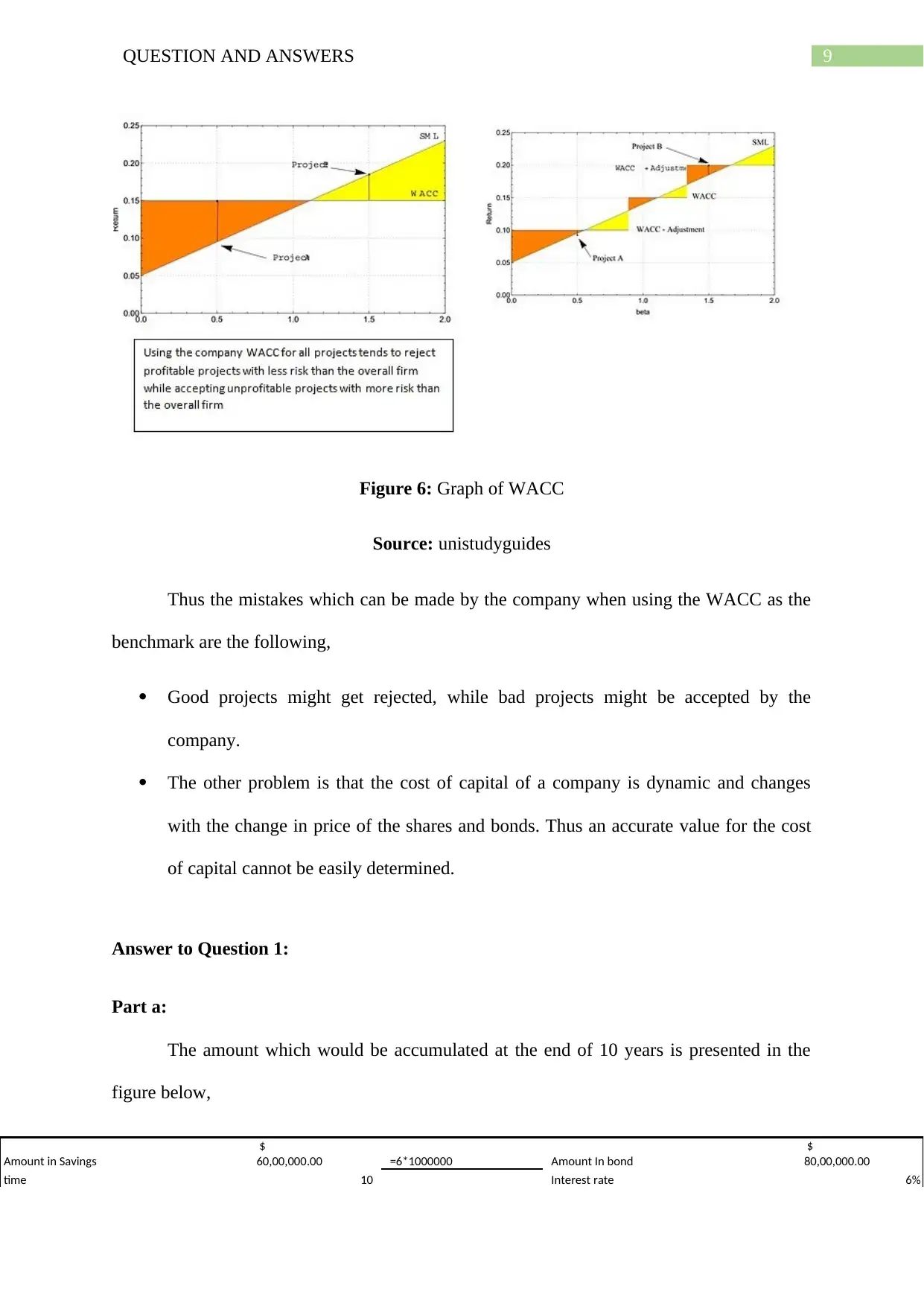
9QUESTION AND ANSWERS
Figure 6: Graph of WACC
Source: unistudyguides
Thus the mistakes which can be made by the company when using the WACC as the
benchmark are the following,
Good projects might get rejected, while bad projects might be accepted by the
company.
The other problem is that the cost of capital of a company is dynamic and changes
with the change in price of the shares and bonds. Thus an accurate value for the cost
of capital cannot be easily determined.
Answer to Question 1:
Part a:
The amount which would be accumulated at the end of 10 years is presented in the
figure below,
Amount in Savings
$
60,00,000.00 =6*1000000 Amount In bond
$
80,00,000.00
time 10 Interest rate 6%
Figure 6: Graph of WACC
Source: unistudyguides
Thus the mistakes which can be made by the company when using the WACC as the
benchmark are the following,
Good projects might get rejected, while bad projects might be accepted by the
company.
The other problem is that the cost of capital of a company is dynamic and changes
with the change in price of the shares and bonds. Thus an accurate value for the cost
of capital cannot be easily determined.
Answer to Question 1:
Part a:
The amount which would be accumulated at the end of 10 years is presented in the
figure below,
Amount in Savings
$
60,00,000.00 =6*1000000 Amount In bond
$
80,00,000.00
time 10 Interest rate 6%
Paraphrase This Document
Need a fresh take? Get an instant paraphrase of this document with our AI Paraphraser
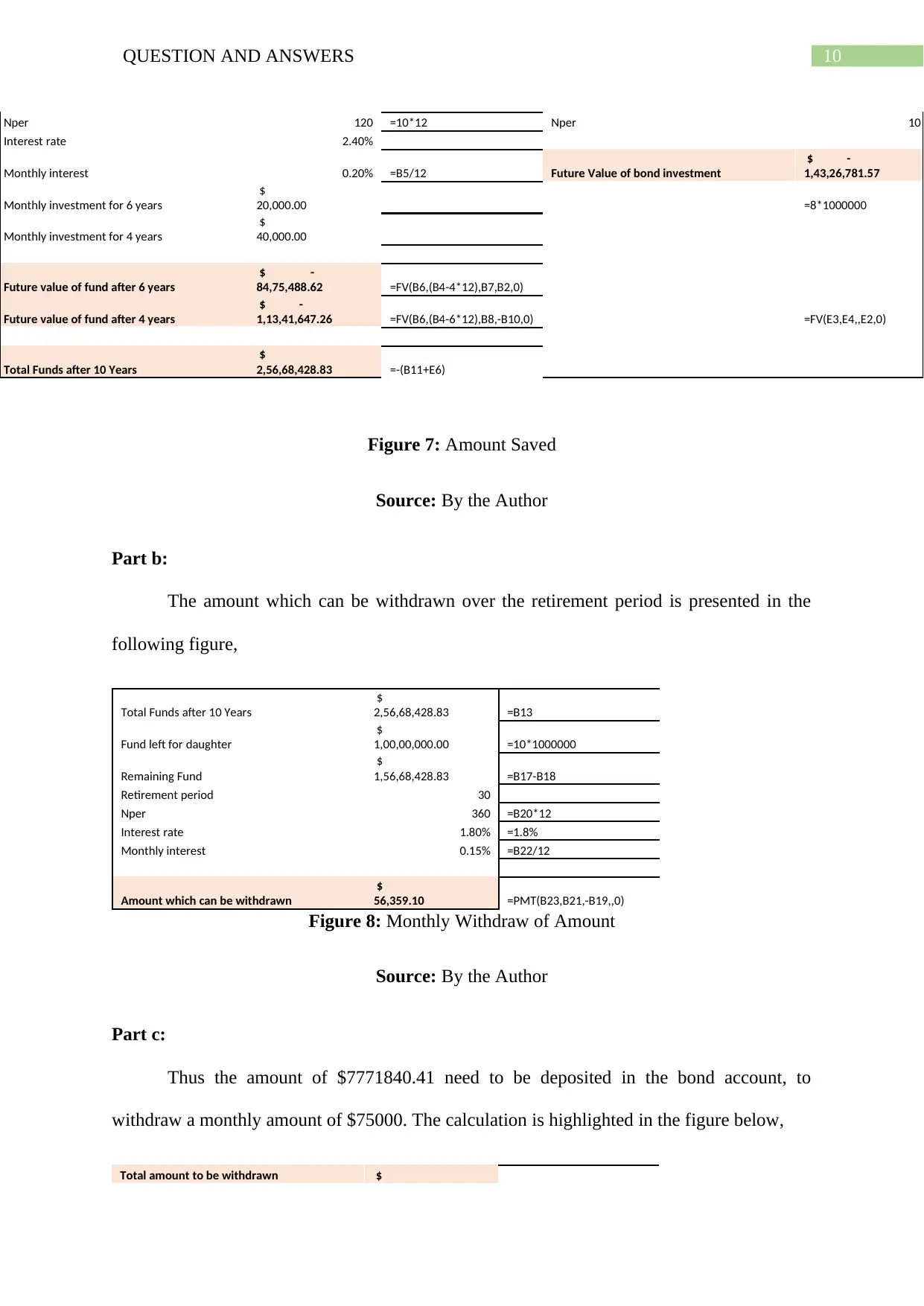
10QUESTION AND ANSWERS
Nper 120 =10*12 Nper 10
Interest rate 2.40%
Monthly interest 0.20% =B5/12 Future Value of bond investment
$ -
1,43,26,781.57
Monthly investment for 6 years
$
20,000.00 =8*1000000
Monthly investment for 4 years
$
40,000.00
Future value of fund after 6 years
$ -
84,75,488.62 =FV(B6,(B4-4*12),B7,B2,0)
Future value of fund after 4 years
$ -
1,13,41,647.26 =FV(B6,(B4-6*12),B8,-B10,0) =FV(E3,E4,,E2,0)
Total Funds after 10 Years
$
2,56,68,428.83 =-(B11+E6)
Figure 7: Amount Saved
Source: By the Author
Part b:
The amount which can be withdrawn over the retirement period is presented in the
following figure,
Total Funds after 10 Years
$
2,56,68,428.83 =B13
Fund left for daughter
$
1,00,00,000.00 =10*1000000
Remaining Fund
$
1,56,68,428.83 =B17-B18
Retirement period 30
Nper 360 =B20*12
Interest rate 1.80% =1.8%
Monthly interest 0.15% =B22/12
Amount which can be withdrawn
$
56,359.10 =PMT(B23,B21,-B19,,0)
Figure 8: Monthly Withdraw of Amount
Source: By the Author
Part c:
Thus the amount of $7771840.41 need to be deposited in the bond account, to
withdraw a monthly amount of $75000. The calculation is highlighted in the figure below,
Total amount to be withdrawn $
Nper 120 =10*12 Nper 10
Interest rate 2.40%
Monthly interest 0.20% =B5/12 Future Value of bond investment
$ -
1,43,26,781.57
Monthly investment for 6 years
$
20,000.00 =8*1000000
Monthly investment for 4 years
$
40,000.00
Future value of fund after 6 years
$ -
84,75,488.62 =FV(B6,(B4-4*12),B7,B2,0)
Future value of fund after 4 years
$ -
1,13,41,647.26 =FV(B6,(B4-6*12),B8,-B10,0) =FV(E3,E4,,E2,0)
Total Funds after 10 Years
$
2,56,68,428.83 =-(B11+E6)
Figure 7: Amount Saved
Source: By the Author
Part b:
The amount which can be withdrawn over the retirement period is presented in the
following figure,
Total Funds after 10 Years
$
2,56,68,428.83 =B13
Fund left for daughter
$
1,00,00,000.00 =10*1000000
Remaining Fund
$
1,56,68,428.83 =B17-B18
Retirement period 30
Nper 360 =B20*12
Interest rate 1.80% =1.8%
Monthly interest 0.15% =B22/12
Amount which can be withdrawn
$
56,359.10 =PMT(B23,B21,-B19,,0)
Figure 8: Monthly Withdraw of Amount
Source: By the Author
Part c:
Thus the amount of $7771840.41 need to be deposited in the bond account, to
withdraw a monthly amount of $75000. The calculation is highlighted in the figure below,
Total amount to be withdrawn $
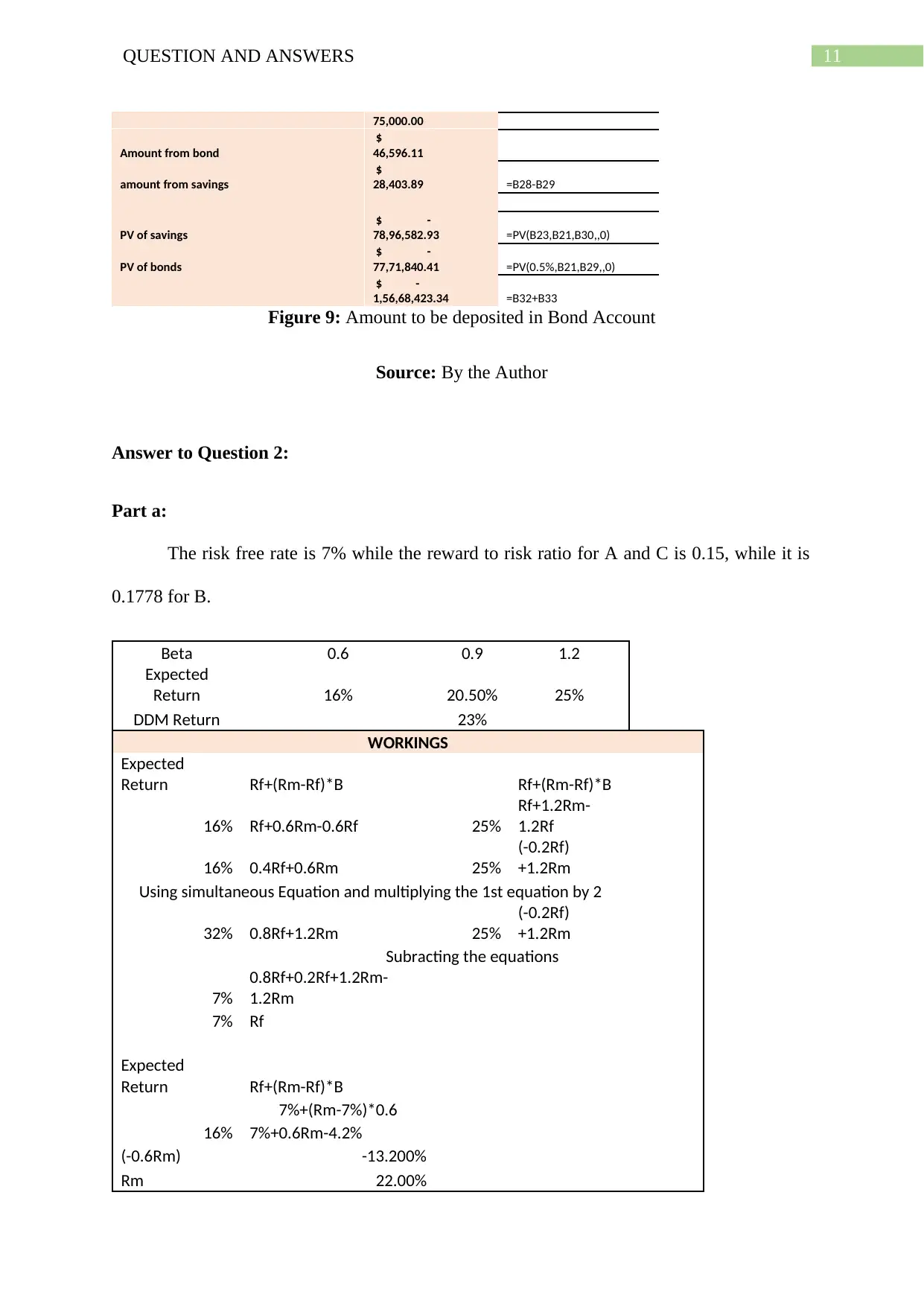
11QUESTION AND ANSWERS
75,000.00
Amount from bond
$
46,596.11
amount from savings
$
28,403.89 =B28-B29
PV of savings
$ -
78,96,582.93 =PV(B23,B21,B30,,0)
PV of bonds
$ -
77,71,840.41 =PV(0.5%,B21,B29,,0)
$ -
1,56,68,423.34 =B32+B33
Figure 9: Amount to be deposited in Bond Account
Source: By the Author
Answer to Question 2:
Part a:
The risk free rate is 7% while the reward to risk ratio for A and C is 0.15, while it is
0.1778 for B.
Beta 0.6 0.9 1.2
Expected
Return 16% 20.50% 25%
DDM Return 23%
WORKINGS
Expected
Return Rf+(Rm-Rf)*B Rf+(Rm-Rf)*B
16% Rf+0.6Rm-0.6Rf 25%
Rf+1.2Rm-
1.2Rf
16% 0.4Rf+0.6Rm 25%
(-0.2Rf)
+1.2Rm
Using simultaneous Equation and multiplying the 1st equation by 2
32% 0.8Rf+1.2Rm 25%
(-0.2Rf)
+1.2Rm
Subracting the equations
7%
0.8Rf+0.2Rf+1.2Rm-
1.2Rm
7% Rf
Expected
Return Rf+(Rm-Rf)*B
7%+(Rm-7%)*0.6
16% 7%+0.6Rm-4.2%
(-0.6Rm) -13.200%
Rm 22.00%
75,000.00
Amount from bond
$
46,596.11
amount from savings
$
28,403.89 =B28-B29
PV of savings
$ -
78,96,582.93 =PV(B23,B21,B30,,0)
PV of bonds
$ -
77,71,840.41 =PV(0.5%,B21,B29,,0)
$ -
1,56,68,423.34 =B32+B33
Figure 9: Amount to be deposited in Bond Account
Source: By the Author
Answer to Question 2:
Part a:
The risk free rate is 7% while the reward to risk ratio for A and C is 0.15, while it is
0.1778 for B.
Beta 0.6 0.9 1.2
Expected
Return 16% 20.50% 25%
DDM Return 23%
WORKINGS
Expected
Return Rf+(Rm-Rf)*B Rf+(Rm-Rf)*B
16% Rf+0.6Rm-0.6Rf 25%
Rf+1.2Rm-
1.2Rf
16% 0.4Rf+0.6Rm 25%
(-0.2Rf)
+1.2Rm
Using simultaneous Equation and multiplying the 1st equation by 2
32% 0.8Rf+1.2Rm 25%
(-0.2Rf)
+1.2Rm
Subracting the equations
7%
0.8Rf+0.2Rf+1.2Rm-
1.2Rm
7% Rf
Expected
Return Rf+(Rm-Rf)*B
7%+(Rm-7%)*0.6
16% 7%+0.6Rm-4.2%
(-0.6Rm) -13.200%
Rm 22.00%
⊘ This is a preview!⊘
Do you want full access?
Subscribe today to unlock all pages.

Trusted by 1+ million students worldwide
1 out of 18
Related Documents
Your All-in-One AI-Powered Toolkit for Academic Success.
+13062052269
info@desklib.com
Available 24*7 on WhatsApp / Email
![[object Object]](/_next/static/media/star-bottom.7253800d.svg)
Unlock your academic potential
Copyright © 2020–2025 A2Z Services. All Rights Reserved. Developed and managed by ZUCOL.





